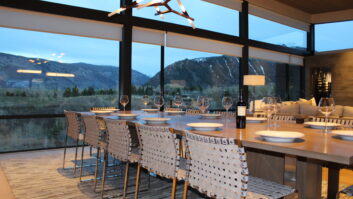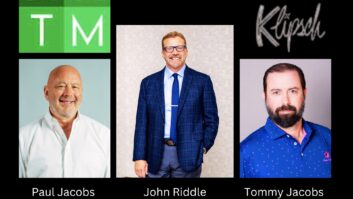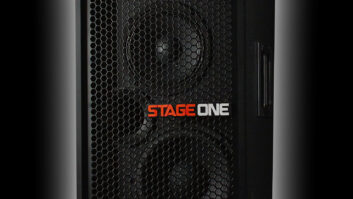TWICE:What’s it like out there in the marketplace now?
Steve Caldero, senior VP/COO, Ken Crane’s: Southern California is still under this big cloud that started in January ’08 with the writer’s strike that shut down the movie industry for 90 days. Our two biggest stores were heavily impacted by that. SAG [the Screen Actors Guild] has still not signed, so that’s still kind of clouding the market.
One of our managers called it the $1,000 Christmas. The guys that would normally come in for that 65-inch set or the premium 50-inch, now it’s like “What can I get for $1,000? We’re going to play it easy this year. I don’t want to talk brackets, no installation. Audio, we’ll worry about later. Can we get something small for that secondary room? But we don’t want to talk about a big expense right now.”
We now have a 30-day price guarantee on purchases. We had more price protection requests in the last eight weeks than we probably had in the previous nine months. People have gotten incredibly aggressive.
We’ve also sold more 40-inch and under sets in the last two months than we sold in probably the last two years. That seems to be the new interest level. People are putting in that secondary TV for a bedroom or an office, but they’re not making big investments in home-theater systems.
TWICE:So is this the new norm? Will consumers continue to be value-driven, even after the economy recovers?
Caldero: I think people are much more aggressive about shopping online and comparing prices. It used to be that our customer, after the purchase — because it was an experiential thing and they whole-purchased with a screen, a system and everything — was happy with what he got at home. Now it’s “I want the screen, and I want the best price on the screen. I’m going to follow up and check on you after I’ve got it home,” and it’s happening in a much more aggressive manner. I think that will continue, yes.
Dan Schwab, co-president, D&H Distributing: Going into this year, consumers are going to be incredibly price-conscious. The people that were looking for the home theater, instead of getting the in-wall speakers, maybe now they’re interested in a sound bar.
There are two things that are going to drive consumers — either price points or the differentiating functionality, whereas before, people had the disposable income and they were willing to spend a little bit more and be a little bit more elaborate with their purchases. In this economy they’re looking at it a little bit differently. That’s going to be with us for a while, and it’s not going to change soon.
David Workman, executive director/COO, Progressive Retailers Organization (PRO Group): I’d say 2009 marks a bit of a watershed in that HDTV is now just TV. We’ve lived in an environment that has been great, and has forced average selling prices up over the last five or six years. We’re talking about a category where six years ago the average selling price was $500. Then the average selling price went to $900. We made money on everything. We saw margins that weren’t historically prevalent in the category. But if you’re a student of this industry you know that all products reach a point where they begin naturally coming down in price. And as the maturation of the category continues, you have to expect it to look more like a commodity business.
That’s alarming because it represents change from what was recent, but it doesn’t mean the end of the world. What it does is to force retailers to seriously rethink how to appeal to the customer, and what their proposition is going to be.
You have to get traffic in the door first and foremost. I think the most dangerous thing, especially to specialists, is to continue to run away from parts of the business to the point that you have no business. This is a business that, for some period of time, has been driven by the television set. That television set is still a great lure. There are still a lot of sets that are going to be sold. I think you have to sometimes rethink what your appeal is going to be, what parts of the business you’re going to play in, and how you create the market basket. Current economics don’t favor that market basket, but that will change.
First you have to figure out how to weather through the short term. Then, when the market does return, you have to look at the changes and figure out how to make a profit. It isn’t all negative — there are people out there that are figuring out how to increase their business over last year. That’s the same today as it was yesterday, and it will be the same tomorrow.
Tom Galanis, operations VP, Sixth Avenue Electronics: History repeats itself, and people have short memories.
Henry Chiarelli, president, DBL Distributing; vice chairman elect, Consumer Electronics Association (CEA): We’ve also had an unnatural event over the past few months. Consumer behavior has been driven by the whole DTV transition. People who traditionally wouldn’t have bought a set feel like now is the time because we have this ominous thing that nobody understands. There was a recent news report by a Phoenix TV station in which they went out to a lot of different retailers and asked the question, “What’s this converter box thing?” One out of 10 got it right, and that was just the salespeople. If salespeople are confused, the customer is certainly confused, and there’s almost a fear factor going on.
Once that unnatural event levels out, consumer behavior will change, but it won’t be because of the economy. It’ll be because we had this thing hanging out here.
Noah Herschman, home and mobile electronics director, Amazon.com: I don’t know if I agree with all that, in that flat-panel TVs are sexy in and of themselves, and are interdependent of those macro forces. They’re the kind of thing you wanted when you were a kid, but they weren’t available. You saw them on “Star Trek.” Now they’re eminently affordable.
Even though our top-selling TV was a 46-inch, our second best-selling TV was a 52-inch, which was unusual for us. We’re starting to see the pricing become more popular, even on the higher-end sets. This is something that had been aspirational, and now people can actually afford it.
And yes, it does help to know you’ll have to get some sort of digital receiving mechanism, although, as we know, it’s not going to affect that many people because cable and satellite penetration is so high. This is only really going to affect the people who receive over-the-air broadcasts.
Chiarelli: They don’t know that, though.
Herschman: True.
TWICE:Amazon had a record holiday season and consumers continue to migrate online for information and purchases. Is e-commerce part of the new paradigm in consumer behavior?
Herschman: People want what they want and they want it fast at a good price. On Dec. 15, our peak day during the holidays, we received 6.3 million orders and shipped 5.6 million units, and 99 percent of orders arrived by Christmas.
The customer has taken charge, and many want to be more informed. A recent CEA [Consumer Electronics Association] study showed a huge influx of online shoppers. Thirty-one percent of folks look at products in the store and then go back to the Web to make the purchase, and customer satisfaction was at 90 percent for CE specialty sites compared to 81 percent for brick-and-mortar CE stores, according to the study.
Speaking for Amazon, we try to deliver the best possible customer experience. Our prices are competitive, either through our site or through our channel partners, and our selection is vast, again thanks in part to the number of merchants on our platform — which happens to include some PRO guys like Vann’s, Abt and Sixth Avenue.
Four out of 10 visitors find our customer reviews helpful, and for those who prefer to speak to a sales person, we have a click-to-call service on the site.
The secret to our success is making sure that customer satisfaction is high. For us, price, selection and convenience are fundamental.
TWICE:Sixth Avenue has also been thriving in a tough environment, and a tough market — New York. What’s your trick, Tom?
Galanis: There really is no trick. You take market share. Whatever percentage the business goes down, it’s going to go down. You just have to take market share at that point.
The other thing is, if you create enough excitement inside your retail locations, people feel comfortable. If you see 50 or 60 people in the store, all interacting with salespeople, then you forget about what’s outside the store. If you walk into a store and there are one or two people inside and it’s quiet, there’s no energy, people are going to want to shop around elsewhere because they’re hesitant at that point. They feel like something’s wrong — it’s too quiet. But if you bring a lot of people into a store and keep the frenzy there — to Dave’s point, by not getting out of a lot of categories that aren’t profitable — people’s wallets open up.
TWICE:Did the expansion into Long Island help?
Galanis: The Long Island stores should do well. Brand recognition is very, very strong for us.
Another advantage we have is that when we advertise specials, we don’t have three or four pieces per store like the nationals. If we decide to put something in the paper, we buy thousands, and there are 100 to 150 pieces per store. On Black Friday we had lines from seven in the morning until seven at night, but everybody that was on that line, no matter what time they showed up, pretty much got what they were looking for because of the quantities. We would have to refill the store with trucks.
We’ve been doing this for the last five years, so the word is out that if we advertise something, you’re going to get it. You’re going to wait in line, but you’re going to get it. That has helped us.
Schwab: What Tom mentioned earlier was right on. In the multibillion-dollar market that we all trade in, there are areas of opportunity. In a difficult economy, it’s going to be up to those that are able to react, tweak their model, look for opportunities.
In certain categories there continues to be growth: notebooks, netbooks, smartphones. When you look across the board, there are certain products that still did very well over the holidays. Our December was very strong. We finished December up 15 percent. I really think it was a matter of focusing on the key products and differentiating yourself in the marketplace so that you’re allowed to continue to drive that value proposition.
We’re in an economy where it’s very hard to see year-over-year growth, strong growth, in any of the traditional CE categories. It’s incumbent on every retailer and everyone in the industry to figure out what their positioning is, how they’re going to differentiate themselves, and how they’re going to find and create new business.
A year ago you could say that everyone grew almost by mistake. It’s like if you were in the real estate industry — even the people that weren’t really smart were making good money. But it’s a different paradigm now. It’s a little bit more of a street fight, a little bit more of where it was a couple years ago.
Workman: We also need to keep cool heads about us, so that the industry doesn’t panic. I sense a little bit of that panic mentality.
Galanis: On a positive note about our industry, we all forget that we’re in the entertainment business. People will cut back for a time, but no matter what happens, they want to be entertained, they crave some form of entertainment. And we sell toys that entertain people.
How long are people going to deprive themselves? At some point they’re going to say, “Maybe I’m staying home, not going out to dinner as much, or whatever. Let me improve this. Let me go out and buy it.” What we sell is not that expensive compared to other things. I don’t want to insult any of the ladies here, but handbags can go for $2,000 to $3,000.
Herschman: So it could be inversely proportional to the cost of travel.
Galanis: Right.
Herschman: And as travel became very expensive with the cost of airline fuel, and also with the fact that it’s very difficult and stressful to fly — staying home and watching TV or listening to music is the way of offsetting that stress.
Galanis: Watching a movie.
Herschman: Video games, all of that.
Jeannette Howe, executive director, Nationwide Marketing Group/Specialty Electronics Nationwide: To Tom’s point, we’re selling environments, entertainment. People still want that. I still feel very optimistic that those nesting urges and the desire to have excitement in your home will continue to be prevalent.
I don’t think we’ll see a lot more footprints coming in the door for traditional retailers. If you don’t see more footprints, you need to bring more eyes to your business, perhaps via the Internet, and you need to get more share of that customer.
Richard Glikes, executive director, Home Theater Specialists of America (HTSA): I’m very optimistic about our new president. I think this will probably change the national attitude. A lot of what’s going on is psyche-driven, and once the psyche changes and there’s a positive feeling, you get consumer confidence going in the other direction —which is a direct barometer to our business system. Confidence goes up, our businesses go up.
At the same time you’ll probably see interest rates being driven down. When you get home mortgages down to 4 to 4.5 percent, people start refinancing again, and they do those additions and those upgrades that they’ve been dreaming about. They become less price-conscious, and that whole engine starts to churn again. That’s where we could come out of this — perhaps by June — when these things start to really come into play.
But in the meantime I’m really worried about March to June. I’m not so worried about July to December. I’m worried from Feb. 17 to about June, and then I think we’ll be O.K.
Caldero: Richard, you touched on an interesting element with the financing. Through this season, consumer finance was a major problem. GE and the rest of the consumer lending people raised the requirements. People who had accounts with them paid them off, came back in and got declined. What happened? Since our name is on the card, it’s like we’re turning them down, which made us look like idiots. They’re all reeling from this credit issue and the availability of money.
Tommy [Galanis] and I were in Japan on a PRO Group trip in September when the whole AIG meltdown happened. I don’t think the American public got the same news we got. The Japanese journalists were reporting how Americans didn’t realize how close to a global meltdown the credit system came with AIG’s collapse. One of the Japanese banks took out a full-page ad in the Financial Times in Tokyo saying they are not an AIG customer to avoid a run on the bank.
I don’t think we’ve ever really seen the full picture of how bad the credit system screwed up and why there’s no money available for customers to buy product or to finance. Rates can come down to 4 percent, but if they’re not making loans, it’s not going to help. That hasn’t changed with all this money they’ve pumped into the credit market.
Workman: We are going to be in a different world relative to the credit market. Not everybody will get approved for credit.
You also had a period of time where for every $100 a person was earning they were spending $117. That is not a sustainable trend. With unemployment numbers being what they are, you have to step back and, optimism aside, look at the prospect of a 3 to 4 percent savings rate. Typically, people will save more money in downtimes, which is occurring already.
These are all the things you have to bake into the expectations. To think the consumer will just go out and start spending more than they make again is an unrealistic expectation right now given current economics. If you believe those things will probably be semi-permanent behavioral shifts, where do you sit in the market? How do you look at the business?













